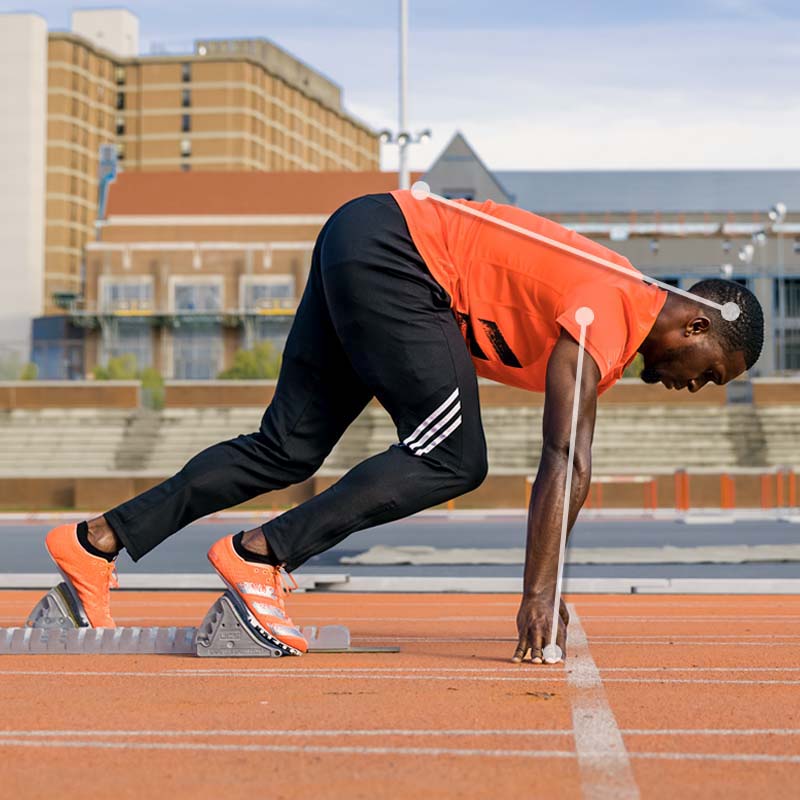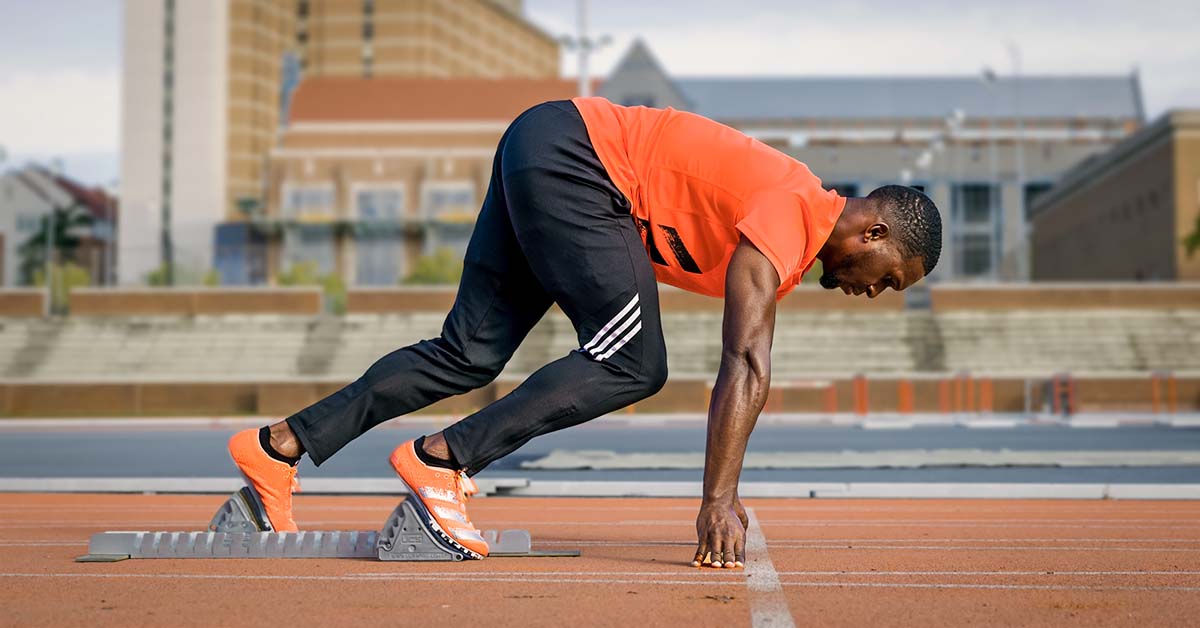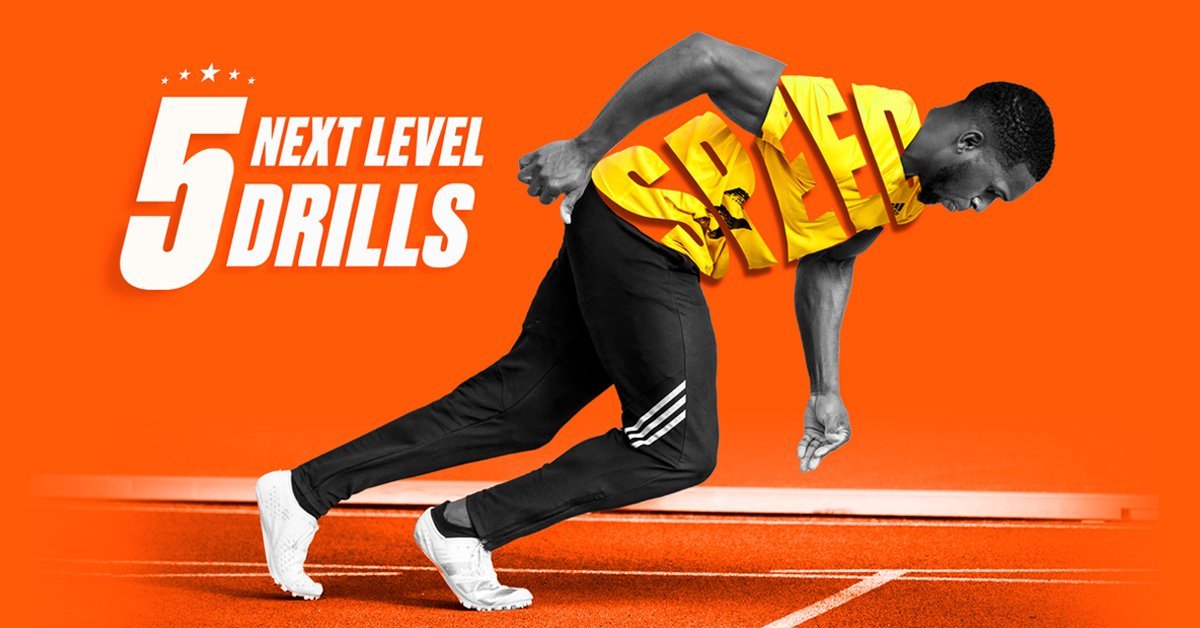
How to set up and perform block starts to maximize your speed.
Block starts for track are the most crucial aspect of sprinting technique, especially for the 100-meter and 200-meter races.
Why? Because your block start is the basis for how fast you can sprint.
The technique you use to come out of the starting blocks sets up every other phase of your sprint, which is why it is essential to develop a proper starting technique.
What makes a good block start? The ability to create maximum linear force down the track in the shortest amount of time.
This force is achieved by:
- Hitting a ~45-degree angle with the body coming out of the blocks.
- Getting into triple extension.


Achieving those two goals isn't as easy as it sounds, and most amateurs don't. It isn't because of a lack of talent or work ethic.
Poor block starts are almost always the result of improper setup and technique.
Fortunately, you can solve both of these issues with the information provided in this guide.
The tips and strategies provided here will help you maximize every element of your block start so you can consistently sprint faster and get on that podium!
If you want to learn how to improve block starts, this is your guide.
Chapter 1: Why do sprinters use starting blocks?
Block starts for track allow sprinters to hit the optimal body positions required to overcome inertia and achieve the fastest possible acceleration from a static position.
A primary goal of sprinting is to accelerate over the longest possible distance in the shortest amount of time.
The quicker an athlete can accelerate to their max velocity, the faster they can run.
Every running event in track and field begins from a static start, which is a critical aspect of the sport. Sprinters would look and train much differently if races had rolling starts.
Why?
Because a static start requires substantial amounts of force to overcome inertia. The initial push out of the blocks is absolutely a power movement.
Do block starts make you faster?
The short answer is yes. If an athlete has:
A. The correct block set up for their anatomy.
AND
B. The ability to execute proper block starting technique.
When both of these criteria are met a sprinter will be able to run substantially faster times with starting blocks than without them.

What is triple extension?
Triple extension is when the ankle, knee, and hip joints simultaneously extend or open.
In kinesiology, extension refers to an increase in the angle of a joint.
When a sprinter hits triple extension, they are getting the maximum amount of power from all of the muscles of the lower body.
Triple extension is a crucial movement for block starts that can be developed in plyometrics like box jumps or strength training exercises such as power cleans.
The use of starting blocks in track allows athletes to get maximum triple extension during the start of the race.
Chapter 2: How To Set Up the Starting Blocks
Step 1 - Spacing for the Pedals
Most athletes have feet that are roughly in proportion to their body size. So a great general starting point is 2 feet from the line to the front pedal and 3 feet to the back pedal.
Keep in mind that this is a starting point. Most athletes will make slight adjustments, i.e., 3 feet plus a hand width to the back pedal.
You want to position the pedals in a way that will allow you to hit the angles and positions discussed in the next section.
So start with these general guidelines and experiment with minor adjustments.


Step 2 - Aligning the Blocks
The pedal angle should be 45 degrees. Again, some athletes might make slight adjustments, but a 45-degree angle is what we are trying to achieve with the body, so this is typically the best position.
Studies suggest that foot plate inclination outside of 45-degrees does not result in more power or faster acceleration.
After you set the blocks, step back and ensure the blocks' spine is in alignment with the track.
Aligning the blocks is a simple step that many beginning sprinters fail to do.
If the blocks are even slightly off, it will compromise your start and lead to unnecessary rotational issues.
Remember, the goal of the block start is to create maximum force down the track.
Finally, you want to step on the blocks, so they are secured down to the track. The last thing you want is for the blocks to slip on the track during your start.


Chapter 3: Getting in the Blocks - Block Start Position
Position 1 - "On Your Marks"
The foot that goes in the front pedal should be the athlete's dominant leg. Typically, this is the leg they naturally jump off or use to kick a ball.
If you are unsure which foot goes in front in starting blocks, then experimenting with both is a good option.
Ultimately it comes down to comfort and which one produces the best results. After a few timed runs, it should be obvious which foot should go in the front pedal.
The hands should be right up to (but not over) the line.
The arms should be perpendicular to the track and shoulder width.
The head and torso should be level to where you could draw a nice straight line connecting them.
The body is relaxed in this position with no muscle tension.

Position 2 - "Set" (the Set Position)
The shoulders should be over the hands and slightly ahead of the starting line.
A common mistake many sprinters make is 'crowding the line.' They throw their shoulders forward, which takes them out of position, reduces power, and can cause a stumble on the first step.
The arms should remain shoulder-width. The athlete will leave the blocks too low if the arms are too wide.
The hips should be above the shoulders.

The front leg should be at 90 degrees. You'll learn why this is important in the next section.
The back leg should be at 120 degrees.

Watch the short video below to see both starting positions and a great example of what 'crowding the line' looks like.
Leaving the Blocks - The Start
Push with the front foot and pull with the back.
When you pull with the back foot, you create a fast motion and allow yourself to stay at one angle (ideally, the 45-degree angle).
An error a lot of younger sprinters make is not maintaining one consistent angle.
They come out of the blocks at one angle, readjust to another angle, then change again.
Changing body angles causes a loss in speed. You want to get to one angle and push down the track.
The Most Effective Online Sprinting Course.
Explore Course90% of the power comes from the front leg.
The requirement for so much single-leg power is why the bulk of sprint training in the weight room is single-leg work. The same thing goes with plyometrics.
Think about it - when are you ever sprinting on two legs? Great block starts require immense single-leg power.
Because that leg is at 90 degrees, it provides the optimal position for power.
The same principle applies to a squat or a box jump; if you go below that, you limit the amount of force you can produce.
From 90 degrees, most athletes can create their optimal power.
Tip: The front shin angle will tell you what the body angle will be. So when watching your block starts, look to see if that front shin angle is correct.

The back leg creates only ~10% of the power. There are two reasons for this.
1. Pushing from the back foot will put the hips into a position that does not allow the athlete to create power down the track.
2. If you push from the back leg, it creates a more extended motion. This longer motion will slow you down. The goal is to get that back foot on the ground as quickly as possible.
The torso should be straight. A rounded body absorbs power rather than transferring it to the track.
Some good drills to develop straight posture are wall drills, assisted sprints, and harness pulls.
Posture is so critical to sprinting that it's the first thing sprints coach Ken Harnden works on in his speed training clinics.
Watch the slow motion video below to see a fantastic example of what these angles and positions should look like.
With a 10.14 second 100 meter PR, Warren Fraser isn't the fastest athlete on the planet - but he is certainly in the running for the best technique.
The arms should be close to a 90 degree angle if the athlete is strong enough. Female sprinters tend to use a wider arm sweep with a larger angle to generate the required force.
The hands and arms should move in a straight line because they will guide the legs. If the arms cross over, it will limit speed by causing unnecessary rotational movement that is not toward the finish line.
Tip: set the blocks up on the lane line to provide a visual cue and assist with lining up your forces down the track.
The head position is crucial. Elite sprint coaches tell their athletes, "don't see where you are going."
This is an excellent coaching cue to help athletes with their head position. Instead of looking straight ahead, you should look at the track 4-5 meters in front of you.
Watch the video below to see what a good eye line and head angle looks like.
If you are looking at the finish line, you change the head angle, which will change the hip angle, moving them backward.
Conversely, if you are looking at your feet, it tucks the hips underneath the body.
Both positions will limit the force you can apply to the track and rob you of speed.
If you want to learn more about sprinting technique during the other phases of the sprint check out this article on proper sprinting form.
TL;DR Watch the the video below for a great recap of how to come out of the blocks.
Chapter 4: Practicing Block starts
Block starts are all about consistency.
Once you have everything dialed in, you want to be able to replicate the same movements you do during practice in a meet situation.
You should be fully recovered and ready to go after a solid 3 step warm up routine.
Most athletes (including elite sprinters) can get about 5-8 quality block starts per session.
Going beyond that provides no additional benefit and can actually hurt your performance.
The reason why is simple - in a meet situation, you will never come out of the blocks in a fatigued state. So it makes absolutely no sense to train that way.
The goal of training is always to maximize our performance during meets.
So how can you improve your starts with a limited number of repetitions per training session?
The answer is by working on 3-point and 4-point starts and a lesser known "mental hack".

The advantage of starting positions that don't incorporate blocks is that they'll help you work on hitting similar angles and sprinting mechanics with a lot less fatigue.
Performing 3 and 4-point starts are very effective because the same rules of sprinting mechanics apply.
That front shin angle at the start will dictate the body angle.
The ratio of force production from the front and back leg will be similar to the block start (mostly pushing from the front leg).
The arm movements will be similar. Even the head and torso angles are the same.
When it comes to sprint training, quality is king. Knowing when to shut it down is just as important as knowing when to push hard.
Now, you do have another powerful tool at your disposal. It doesn't require any physical movement and its been scientifically proven over the past 50 years.
It's called mental practice and it can have a profound impact on sprinting technique and track meet performance.
Research shows that mental rehearsal activates the same neural pathways as physical practice, helping athletes to improve performance and strengthen movement patterns.
When performed correctly, mental practice allows sprinters to gain virtually unlimited block start practice.
If you'd like to learn more about sprint training and maximizing speed, check out Ken Harnden's sprinting master class, Sprinting Smarter, Speed Progression.








Nyc
This is the best breakdown of block starts I have seen on the web, simply fantastic! Reducing the amount of power with the back foot has been a game changer, thank you!
Thank you Ethan, glad it was helpful!
Hey everyone, I just wanted to take a moment to appreciate the abundance of free information available to us. From educational resources to helpful tutorials, it's incredible how much knowledge we have at our fingertips. Let's never take it for granted and continue to learn and grow. Thank you to all those who contribute to this wealth of information! 📚💡"
Thank you Atharv for sharing your appreciation! We're glad to contribute to this wealth of information and help foster a community of continuous learning and growth in track and field. Your gratitude inspires us to keep creating and sharing valuable content.
Thank you for the valuable information being a senior track competitor I had forgotten my past learning. Now I just need the body to cooperate ha!
Thanks so much for the kind words! We’re glad the article helped bring some of that past knowledge back. To ease back in, start with various 2-point and 3-point starts. It's a great way to retrain the body without putting too much strain on it right away. Best of luck!
Thank you for sharing this wealth of information. I wish I had this great breakdown back when I was competing. The pictures and videos are super helpful.
Thank you! Really glad to hear it resonated with you. We definitely try to include the kind of breakdowns we wish we had back in the day too, glad the photos and videos helped bring it to life!